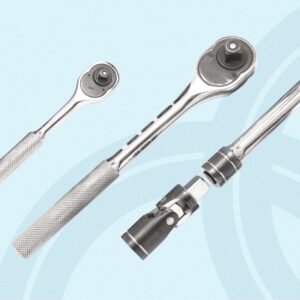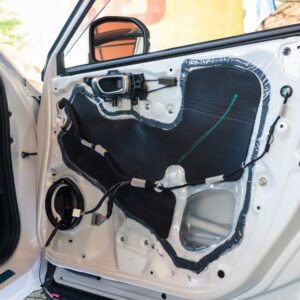Soft top roofs might seem delicate, but they’re incredibly sturdy despite their flexible nature. They can handle strong winds when you’re traveling at high speeds without any issues. That said, soft tops aren’t as durable as hardtops, which are typically made from rigid metal. Over time, your soft top roof can get cut or pierced, which is going to cause water to leak into your cabin.
What Are Convertible Roofs Made Of?
Convertible roofs are typically made from vinyl or canvas. These materials allow the roof to fold quickly and neatly without motorized assistance, which is usually the case in hardtop convertibles.
Vinyl
Vinyl has always been a go-to material choice when it comes to vintage convertibles since it’s easy to maintain and extremely durable. Vinyl soft tops are also easier to clean compared to their cloth counterparts. In addition, a lot of people like the glossy appearance that somewhat mimics the look of leather found on horse buggies.
Over time, adverse weather conditions can cause vinyl soft tops to peel and crack. This kind of damage is unrepairable. Hence, damaged vinyl tops can only be replaced.
Fabric
Fabric tops (which are also called canvas or cloth tops) are the most common materials used for modern convertible tops. Most fabric tops are constructed from three layers: an exterior layer made of acrylic square weave, an inner layer made of butyl rubber, and an interior layer lined with cotton drill. Unlike vinyl, fabric convertible tops come in a wide range of colors.
Cloth tops require more maintenance than vinyl tops because the exterior square weave collects dirt easily. Unlike vinyl tops, which must be replaced when damaged, fabric tops can be repaired.
How to Fix a Convertible Top
Replacing the entire soft top might seem like the easiest solution. However, this is going to be costly. Several convertible soft top repair methods are relatively straightforward and you can do them on your own without a mechanic.
Remove the Soft Top Roof Assembly
Convertible top tears tend to be small. These cuts are typically never larger than a finger, but they’re big enough to let in water. If your roof has a large cut, then you might want to remove the whole soft top from the vehicle to make the repair process easier. After removing the roof, you can place the fabric on a table or floor where you can properly work on the damage. However, if the cuts are small, then you can proceed to repair them without removing the soft top from your vehicle.
Cut Off Loose Threads
The loose threads from the damaged area must be cut. Otherwise, they can unravel and spread the damage. Ideally, these fiber strands should be cut using sharp scissors rather than pulled to avoid further fabric damage.
Sew the Tears
You’ll need a strong thread and a curved needle to sew the ripped cloth closed. You can use a leather sewing kit or a sail repair kit. There are also some convertible top repair kits available online. Keep in mind that sewing can take some time, so exercise some patience while working on the project. To close the tear, you should use a cross-stitch pattern. This pattern involves sewing diagonal lines across the tear, then coming back and making another pass to create an “X” pattern. To achieve the cleanest look, you should use thread that matches your soft top’s color.
Use a Vinyl Adhesive
Stitching the soft top fabric won’t be enough to prevent water from leaking inside your cabin. Most convertible tops also have a butyl layer sandwiched between the inner and outer fabrics to prevent water from penetrating. To create a waterproof layer, you’ll need a vinyl adhesive, which is meant to repair small cuts in leather, vinyl, and fabric. When this adhesive dries up, it’ll create a watertight seal.
Use a Soft Top Repair Kit
There are soft top repair kits online that are composed of strips of vinyl, a special glue, tape, and a small plastic spatula to apply the glue. The kit inclusions can vary depending on the kit you purchase.
Using the repair kit involves cleaning the area surrounding the damaged soft top using alcohol to ensure there aren’t any particles that might affect the adhesion. The piece of tape is cut and applied to the inside part of the soft top. Then, cut the strip of vinyl to a size that’s slightly bigger than the hole. Evenly apply the glue onto the vinyl patch using the spatula and ensure there aren’t any raised edges.
These repair tips won’t make your soft top look new again. That said, repairing the holes will prevent water from entering your cabin. Plus, mending the cut can prevent the hole from getting larger over time.
Once you’ve repaired your convertible using the previously mentioned methods, remember that these repairs are just temporary. Depending on how well you’ve repaired the hole, it can last up to a few months or years. After a certain period, the damaged area can eventually open up and leak. When this happens, you can attempt to repair it again with the previously mentioned processes, but the best solution is still to replace the damaged top.
Any information provided on this Website is for informational purposes only and is not intended to replace consultation with a professional mechanic. The accuracy and timeliness of the information may change from the time of publication.






































